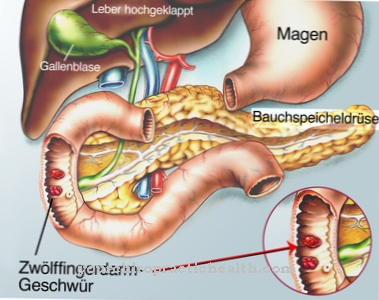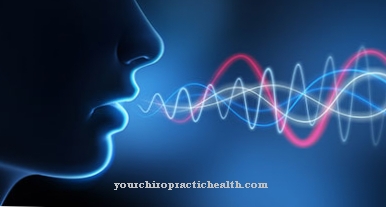Each vertebra is responsible for the supply of one organ. If the head hurts or stomach pain is noticeable, this can also originate from the spine. Displacements of just one millimeter with serious consequences: Vertebral blockages; Triggers sharp pain and the cause of most back problems.
What is a vertebral block?

The individual vertebrae are held together by small facet joints and ligaments. These enable the head to be turned on its side or the person to bend forward. The intervertebral discs are located between the vertebrae and prevent the vertebrae from colliding directly.
Overstretched ligaments mean that they are no longer strong enough to hold the vertebrae in place. If intervertebral disc fluid leaks, the vertebrae run out of space and shift. The consequence is a restriction of movement and is called a vertebral blockage. These blockages do not include restrictions caused by inflammation.
causes
The causes of a vertebral blockage differ depending on the affected vertebral area. The cervical vertebrae are most often displaced by blunt external influences. The classic case is whiplash. The first vertebra, the atlas, is connected to the head via a ball joint.
Between the vertebra and this joint and also between the first and second vertebrae there is no protective intervertebral disc, which acts like a shock absorber. Blockages in the thoracic vertebrae are due to an unhealthy lifestyle for the musculoskeletal system. Sitting on a rigid surface, leaning forward and not stretching enough to take care of the intervertebral discs.
In the lumbar vertebrae, the muscles that are usually inadequate are responsible for a blockage, as is slipped discs. It is not uncommon for the incorrect lifting of heavy loads to be sufficient and a sharp pain to be felt immediately. In order to keep the spine straight when the pelvis is inclined, the supporting apparatus not only helps the muscles but also the first cervical vertebra. The result is a straight spine, but a displaced atlas vertebra.
Symptoms, ailments & signs
A vertebral block usually leads to severe discomfort in the first few days. These then subside by themselves. Symptoms appear on the cervical vertebrae, thoracic vertebrae, lumbar vertebrae, or the tailbone. Those affected regularly have to accept restricted mobility. In addition to pain in the respective vertebrae, signs also extend to other parts of the body.
The body automatically adopts a gentle posture in the event of vertebral blockages.This creates stress on other parts of the body, which in the long term favor poor posture. Most patients go to the doctor because of a cervical spine blockage. You complain of severe neck pain. In addition, the head can only be moved to the left or right to a limited extent.
The blockages are often accompanied by headaches and fatigue. The thoracic spine blockage sometimes causes breathing and musculoskeletal problems. The area around the abdomen is also often affected. Patients sometimes complain of indigestion. The best known sign of a lumbar blockage is lumbago.
But other symptoms such as cramps in the abdominal area, back pain or circulatory disorders can also accompany an illness. Leg cramps extend the signs to the legs. If the tailbone is affected, abdominal pain sometimes occurs. Those affected describe the sitting position as extremely uncomfortable. Anus itch and constipation also occasionally develop.
Diagnosis & course
At the beginning of the vertebral blockage, the surrounding muscles compensate for the misalignment in order to prevent greater pain. However, this relieving posture in turn leads to tension. Muscle tension is always accompanied by a constriction of the nerves; the spiral nerves, which are responsible for supplying the organs, report themselves and that inevitably triggers pain.
It is not uncommon for the attending physician to suspect other causes first. If the thoracic vertebrae are slightly displaced, the heart or lungs cannot be properly supplied, which can sometimes be noticeable in breathing difficulties. A clear diagnosis is difficult. Only a herniated disc can be visibly identified by means of an imaging procedure. With the naked eye, however, a long-term misalignment of the spine due to a pelvic inclination can be seen.
So that the spine and head stay as straight as possible, the atlas vertebra at the other end compensates for the inclined position. The muscles in one half of the body are overstretched, the other half shortened. If this blockage is left untreated for a long time, chronic pain is the result.
Complications
In most cases, a vertebral block causes severe pain and leads to massive restrictions on movement. Vertebral blockages occur frequently and are usually harmless; in most cases they will go away on their own if the incorrect posture that led to the blockage is corrected. But if a nerve is pinched, abnormal sensations up to paralysis can occur.
Symptoms of paralysis in the arms or legs must be examined and treated by a doctor. In most cases, a vertebral block causes severe pain and restricted mobility, which can severely limit the person affected in their everyday life. Blockages in the back, shoulders and cervical spine often radiate into the head and cause headaches.
The symptoms can also limit the function of the heart and lungs; in worse cases, vertebral blockages can also cause shortness of breath and heart problems. If the pain does not go away even when lying down, the quality of sleep suffers. Caution is advised during chiropractic adjustment of the blocked vertebrae, especially with blockages in the cervical spine. In the worst case, such interventions can cause herniated discs and strokes.
When should you go to the doctor?
If there are irregularities in mobility in the back area after a turning movement, during sporting activities, an accident, violence or a fall, a doctor should be consulted to clarify the symptoms. If there are only slight discrepancies, sufficient rest and rest can be enough to bring about relief from the symptoms. The prerequisite for this is that there is a significant improvement in the overall situation with a sufficient supply of heat and a restful night's sleep.
However, if the impairments continue unabated or if they increase in intensity, help should be sought immediately. In the case of severe pain, a visit to a doctor is also advisable to clarify the cause. If tensions, headaches or restrictions in general movement sequences appear, these are alarm signals from the organism. Functional disorders, tiredness and abdominal discomfort can also indicate irregularities in the spine.
Breathing disorders and changes in heart rhythm are signs of impaired health and should be investigated as soon as possible. To avoid complications or secondary diseases, medical treatment is advisable. If the daily routines can no longer be carried out without symptoms or if participation in sports activities is not possible, a doctor is required. The permanent use of a relieving posture or incorrect posture of the skeletal system also indicates disorders that would have to be treated.
Treatment & Therapy
Blocked vertebrae lead to limited mobility. It may sound like a paradox under this circumstance, but exercise relieves pain. Displaced vertebrae even find their way back into the correct position on their own if the environment is sufficiently strengthened.
If the tension is untreated and massive for a long time, the doctor eases the pain by means of infusions or infiltration before the exercise therapy. Only then can the vertebrae be stretched back into the correct position with massages or physiotherapy. Chiropractic adjusts vertebrae with targeted overstretching at the affected area. In the case of minor shifts, this jerky intervention is rarely necessary and can also be achieved with more gentle methods.
Caution is also advised when the cervical spine is blocked because several nerve cords from the spinal cord go into the head and the arteries are close to these vertebrae. With the Dorn method, the patient moves arms or legs in a pendulum fashion and at the same time the therapist gently pushes the vertebrae into the correct position.
The prerequisite for this is that the vertebral blockage does not originate from a herniated disc and that painful nerve inflammation is excluded. The compression of the spine that occurs during the day due to long periods of sitting and a lack of exercise can also be relieved by anyone using gravity: hanging. It doesn't matter whether you hold onto the bar with your hands and let your feet dangle or vice versa.
You can find your medication here
➔ Medicines for back painprevention
Movement and targeted strengthening of the neck and back muscles prevent vertebral blockages. If the activity is mainly sedentary, the muscles do not fall into an unnatural posture that leads to tension.
Regular breaks with targeted relief exercises also keep the facet joints between the vertebrae flexible. Exercise and movement in general lead to a good supply of the intervertebral discs, which thus remain elastic.
The nightly relaxation should not be underestimated either: a sleeper moves on average every ten minutes, but the head usually remains on the cushion. If this is too high, the cervical vertebrae shift. The body shows its displeasure in the apparently more comfortable prone position, which also affects the cervical area.
Aftercare
The ideal follow-up care for a vertebral block depends on several factors. This includes the cause of the blockage, if it can be determined, the degree and location of the vertebral blockage. It is also important to know whether it was a one-off event or whether the vertebral bodies have already been blocked at this point.
Follow-up care can be arranged with the physiotherapist or orthopedist, but also with sports teachers or fitness trainers with the appropriate qualifications. The pain that the vertebral blockage often brings with it often leads to tension in the muscles. In this context, aftercare can alleviate the symptoms by giving the patient massages and taking relaxing baths. A hot water bottle or hot cherry stone pillow can also promise relief.
Often it is also one-sided loads or an incorrect posture in connection with muscular imbalance that can trigger the vertebral blockage. Here it is also part of the aftercare that the patient thinks about the ergonomics at his workplace or compensates for the imbalance of his muscles through training and thus stabilizes the spine physiologically. Weak muscles (often in the abdomen and upper back) need to be strengthened, while shortened muscles (often in the chest area) need to be stretched gently but consistently.
You can do that yourself
A vertebral blockage can be solved yourself if necessary. In consultation with a sports doctor, various exercises and techniques are recommended, such as the COX technique, in which the vertebrae are stretched and brought into the correct position. Popular techniques such as hanging out or back swing are also available. However, you must never press or tear hard.
If you experience pain, restricted mobility or other problems, you should consult your doctor. Visiting a chiropractor is particularly recommended for severe vertebral blockages and other back problems. The specialist can provide further self-help tips and professionally resolve the vertebral blockage.
An acute vertebral blockage, as it can occur, for example, in the form of lumbago, initially requires protection. Sufferers should lie down until the pain subsides. The blockage can then be released with gentle movements. If this does not improve the symptoms, there may be severe tension, which must be relieved by a massage or chiropractic mobilization. Connected to the therapy, possible triggers and risk factors for vertebral blockages must be found and remedied, such as incorrect or overloading or a lack of exercise.
























.jpg)



